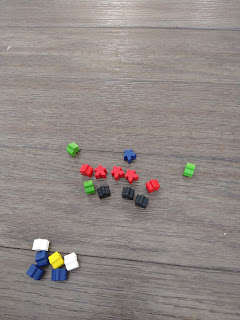In my post about our hexcrawl sessions, I was trying to show my son the difference between visceral and existential threats by using ghouls as the monster.
Ghouls are ghoulish. They are the wolves of the undead world. On either of two attacks, they can paralyze a target. And then they eat you. There is also the concept of being turned into a ghoul, which is out of scope mechanically but may hang out in your player's head. Dang, that's all so scary. It's also existential as it begs the question, do you want to engage this threat or flee?
Unless you are an elf who is immune. Or if you don't know what a ghoul is or does, then it's less scary. The existential threat changes from fear of being eaten alive (existential) to the likelihood of loss of life or limb (visceral).
In these events, a paladin slammed into a pack of 5 ghouls not realizing what they were. No one did. Once the paladin was paralyzed, everyone realized what these things could do. The party had a choice: try to regroup and come up with a plan or press the attack.They decided to press the attack for a couple of reasons. First, I was trying to explain to my son that a pack of ghouls against 4th level characters isn't much of a threat.
Ghouls have 9 hp, which makes them 2 or 3 hit monsters. I come from a wargaming background where hits count. With a d6, the average roll is 3.5. That's your damage against the 9 they have. Chances are you will kill them in 2 to 3 rounds and in that last round, they won't have time to do anything important.
Second, in pressing the attack, the party was preventing the downed Paladin from being eaten. The party had the ghouls outnumbered. The rank closing in on the ghouls was made up of a Fighter, an Elf, a Cleric, and a Ranger. On the wings, a Bard and Theif had bows ready. I used green to display characters that were not threatened by the ghoul's special attack: the Elf by her nature, and the Bard and thief were at a safe distance.
My son objected to this as the ghouls swing twice. But they are facing armored opponents and have much less of a chance of hitting than the player characters do. Additionally, they strike with much less power, 1d3 hp. If they hit, then the paralysis comes into play. That is a whole other die roll where the player characters stand a good chance to resist.
I explained to him that the threat is the most important part of the fight. With the odds loaded in the players' favor, the ghouls don't have much of a chance of winning. The players should know that, but maybe they don't.
That's great. The Cleric is in the front rank and has a chance of pulling a Big Damn Hero moment by attempting to turn. Potentially, the Cleric could take out some or all of them. If a ghoul paralyzed someone, the Bard and the Theif have a moment to save the day with a timely arrow. Even an unaware party has some great counter moves for a paralyzed character.
Thanks to some really awesome die rolls (from the DM's perspective), the last round of combat occurred simultaneously. In the exchange Rolf, the Fighter was hit and paralyzed as he took out his ghoul. I could not have planned that outcome, thanks to random dice.
"So, what happens next? How long are the paralyzed?" my son asked.
My answer was simple. The rules don't say, so I guess I, the DM can keep this sense of dread up as long as I want to. In a hexcrawl, that really doesn't come up as much as it does in a dungeon. A hexcrawl is ruled by long-term mechanics, usually days over minutes. Hurrying in a hexcrawl is done in hourly increments. By any reasonable measure, the paralyzed characters will be up before the DM has to call another event.
A party in a dungeon doesn't have the luxury of waiting it out. They will if they have to, but that cranks up the threat level. Stuff happens fast. When in a dungeon setting I will tell every player that they feel the effects of paralyzation kicking in regardless of their saving throw:
"Your arm feels like putty and lead..."
"Pins and needles race up your leg..."
"You are so cold..."
Unless I feel it's too much stress, that is. Sometimes, the players don't need more stress. It's a judgment call that needs to be made in the moment.
So what happens next? In this case, the party took action that resolves everything. They dropped the tent and walked the Paladin and the Fighter to the hex with trees and shrubs. Then some return to pick up the tent and settle in for the night. Presumably, the Fighter and Paladin will stand up on their own before morning.
The great thing about ghouls against a well-trained and armed party is you can adjust the feeling of threat without tinkering with mechanics or dice rolls.
Since I mention dice rolls so much, The Red Dice Diaries has a nice pair of episodes on fudging die rolls.



















.jpg)





